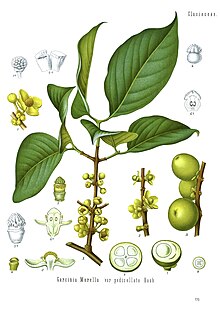Garcinia morella: Difference between revisions
→Uses: ce; +wikilinks |
|||
| Line 39: | Line 39: | ||
==Uses== |
==Uses== |
||
Ripe fruits can be eaten but they are very acidic. Just like other garcinia varieties such as [[kokum]] |
Ripe fruits can be eaten but they are very acidic. Just like other garcinia varieties such as [[kokum]] (which is prevalent in the Indian west coast) or [[garcinia pedunculata]], the fruit can be preserved by slicing into thin pieces and then drying under sun. It can be made into pickles. [[Bodo people|Bodos]] cook the unripe fruit as vegetable with fish. A [[chutney]] can be made by boiling the fruit. In [[Assam]], dried and preserved slices are added to black green pulses to make a popular slightly acidic curry. Dried up fruit slices are valued as a traditional remedy for [[dysentery]].<ref name="WILD" /> |
||
==Chemistry== |
==Chemistry== |
||
Revision as of 06:28, 24 October 2014
| Garcinia morella | |
|---|---|

| |
| Scientific classification | |
| Kingdom: | |
| (unranked): | |
| (unranked): | |
| (unranked): | |
| Order: | |
| Family: | |
| Subfamily: | |
| Tribe: | |
| Genus: | |
| Species: | G. morella
|
| Binomial name | |
| Garcinia morella | |
| Synonyms | |
|
Garcinia gaudichaudii , Mangostana morella Gaertn. , Garcinia elliptica Wall. , Garcinia guttaWt.[1] | |
Garcinia morella is a species of tree in the Clusiaceae family found in India, Sri Lanka and southern Philippines.
Common names
- Assamese: Kujee Thekera (কুজী ঠেকেৰা)[2]
- English: gamboge (Sri Lanka), gamboge (India)
- Tamil: iravasinni (இரேவற்சின்னி), makki
- Malayalam: iravi, chigiri
- Kannada: ardala, devana huli, jirigehuli, murina huli, ponpuli
- Sinhalese: gokatiya, kokatiya
- Visayan languages (Philippines): batuan
Description
Trees are up to 12 m tall. Bark is smooth, and dark brown in color; blaze white.
Leaves simple, opposite, decussate; petiole 0.6-1.5 cm long, canaliculate, sheathing at base, glabrous; lamina 6.5-15 x 3.5-8 cm, usually elliptic, sometimes narrow obovate, apex acute to acuminate, base attenuate; coriaceous or subcoriaceous, glabrous; secondary_nerves 6-8 pairs; tertiary_nerves obscure.
Flowers show inflorescence and are dioecious; male flowers in fascicles, axillary; female flowers larger than male, solitary, axillary.
Uses
Ripe fruits can be eaten but they are very acidic. Just like other garcinia varieties such as kokum (which is prevalent in the Indian west coast) or garcinia pedunculata, the fruit can be preserved by slicing into thin pieces and then drying under sun. It can be made into pickles. Bodos cook the unripe fruit as vegetable with fish. A chutney can be made by boiling the fruit. In Assam, dried and preserved slices are added to black green pulses to make a popular slightly acidic curry. Dried up fruit slices are valued as a traditional remedy for dysentery.[2]
Chemistry
The xanthonoids gaudichaudione A, B, C, D, E, F, G, H, gaudichaudiic acid A, B, C, D, E, morellic acid and forbesione from G. gaudichaudii.[3]
References
- ^ Garcinia morella on www.globinmed.com
- ^ a b "Wild Edible Plants of Assam" (PDF). Director, Forest Communication, Forest Department, Assam, India.
- ^ Novel cytotoxic polyprenylated xanthonoids from Garcinia gaudichaudii (Guttiferae). Shu-Geng Cao, Valerie H. L. Sng, Xiao-Hua Wu, a, Keng-Yeow Sim, B. H. K. Tan, J. T. Pereira and S. H. Goh, Tetrahedron, Volume 54, Issue 36, 3 September 1998, Pages 10915-10924, doi:10.1016/S0040-4020(98)00644-9
